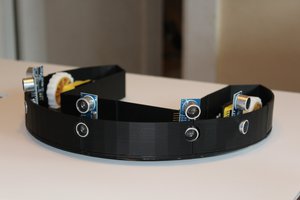This project started as a low cost robot that was buildable and programmable by Computer Science Majors here at VT to give them some hardware experience. Since then it evolved into an outreach tool for the ECE department, and is currently being used for a high school summer camp. The platform is cheap enough that students can be given kits to build, keep and take home.
The platform is controlled through a webpage hosted on the onion omega2, with a real or virtual joystick being used as an input. An accelerometer breakout board is mounted on the front of the rover, which activates an autocycling RGB after an impact.
The platform is powered by a protected 18650 cell and includes an integrated usb charger.
Total cost: ~$30 per rover in quantities of 50 rovers!
(A single robot is like ~$45 if you want to build one, and all the ebay parts are available on Amazon for more money)
 williamg42
williamg42





 Keith Elliott
Keith Elliott
 mauswerkz
mauswerkz
 David
David
 Simone Tolomei
Simone Tolomei
I did not, since the 1 Amp cut off current meant they were completely useless for newer generations of rovers . I would not be surprised if their real capacity was less than the stated capacity, especially since they seemed fairly light compared to the samsung cells we were also testing. Honestly I will never buy LiPo from eBay or Ultrafires again, it's not worth the risk. Those Liionwholesale cells are the real deal and are cheap enough.